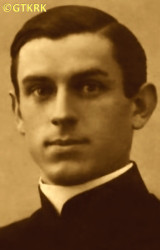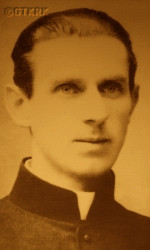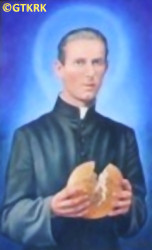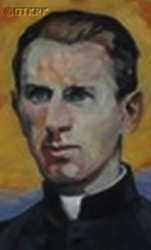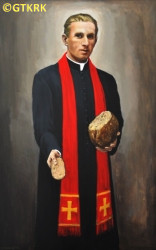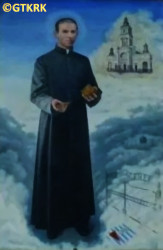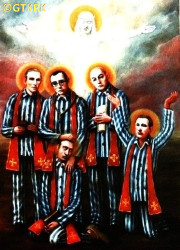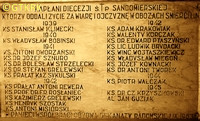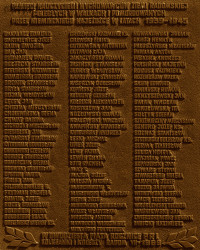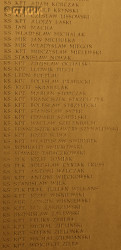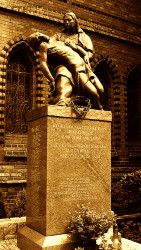Roman Catholic
St Sigismund parish
05-507 Słomczyn
85 Wiślana Str.
Konstancin deanery
Warsaw archdiocese, Poland
full list:
displayClick to display full list

searchClick to search full list by categories
wyświetlKliknij by wyświetlić pełną listę po polsku

szukajKliknij by przeszukać listę wg kategorii po polsku

Martyrology of the clergy — Poland
XX century (1914 – 1989)
personal data
religious status
blessed
surname
STRZELECKI
forename(s)
Boleslav (pl. Bolesław)
beatification date
13.06.1999more on
www.swzygmunt.knc.pl
[access: 2013.05.19]

the RC Pope John Paul IImore on
en.wikipedia.org
[access: 2014.09.21]
function
diocesan priest
creed
Latin (Roman Catholic) Church RCmore on
en.wikipedia.org
[access: 2014.09.21]
diocese / province
Sandomierz diocesemore on
en.wikipedia.org
[access: 2013.05.19]
RC Military Ordinariate of Polandmore on
en.wikipedia.org
[access: 2014.12.20]
academic distinctions
Doctor of Canon Law
honorary titles
„Polonia Restituta” Cross — 5th Class, Knight'smore on
„Polonia Restituta” Cross – 5th_Class, Knight's
(1929)
Gold „Cross of Merit”more on
Gold „Cross of Merit”
date and place
of death
02.05.1941

KL Auschwitzconcentration camp
today: Oświęcim, Oświęcim gm., Oświęcim pov., Lesser Poland voiv., Poland
more on
en.wikipedia.org
[access: 2022.01.09]
details of death
In 1920, in the face of the Russian threat during the Polish–Russian War of 1919‐1921, prob. voluntarily joined the Polish Army. Prob. was assigned as a chaplain of the reserve battalion of the 18th Infantry Regiment, stationed in the Konin garrison. In 1919, the Regiment, after battles with the Ukrainians during the Polish–Ukrainian War of 1919‐1921, remained in Volyn, on the front of the budding Polish–Russian War. From there, on 24.04.1920 it began its attack at the beginning of the Kiev expedition, but after the capture of Korosten, it was sent to Kozyatyn in the Vinnytsia region, as a reserve of the command. There, in 05.1920, in connection with the events on the Lithuanian–Belarusian Front, the Regiment was divided — some of the battalions were transferred to the Berezina river front line in the north, some remained in Kozyatyn. And then prob. was sent as a chaplain to the battalions remaining in Ukraine. Was there when at the beginning of 06.1920 the Russian offensive on the Ukrainian Front began and the Polish troops, under pressure from, among others, the Rus. Первая Конная армия (Eng. 1st Cavalry Army), under the command of General Semyon Budyonny, began to retreat westward. Initially they withdrew to the line of the Ubort and Sluch rivers. On 01.07.1920 the 2nd Battalion of the Regiment in a tactical counter–offensive in the vicinity of Korets in Volyn engaged in a heavy fight with the Russians. Since the order to retreat did not reach it, it was surrounded and cut down in a sabre fight. Few of the soldiers survived. According to some sources, it was during this battle, distinguished himself… On 01‐09.08.1920 The Regiment — now complete, with the remnants of the 2nd Battalion — defended the Bug River line. From there, withdrew to Garwolin and in Góra Kalwaria crossed over to the western bank of the Vistula. Was there when the decisive Battle of Warsaw (known as the „Miracle on the Vistula”) began on c. 15.08.1920. On 17.08.1920 transferred to the northern front. There, near Ćwieklinko north of Płońsk, took part in the last major battle, defeating the Russians. On 01.09.1920 was transferred back to Ukraine, to the line of the Svirzh River near Rohatyn. There, took part in several clashes with the Russians, and finally, after break throught the front line, in driving the Russians towards east, towards Naraiv, which the Regiment captured on 25.09.1920. From there, on 03.10.1920, was transported to the border with Lithuania.
On 25.11.1920, the Regiment was transferred back to Łomża. And it is likely that there, in 12.1920, was placed on leave. On 12.04.1921, was released from the Polish Army and transferred to the reserves. Also in 1923, 1924, 1925, 1927 and 1929, was appointed chaplain of the reserve of the Polish Army (from 25.11.1926, each time for a statutory period of 2 years).
After German and Russian invasion of Poland in 09.1939 and start of the World War II, after start of German occupation, for the first time arrested by the Germans on 27.10.1939.
Held as a hostage and after some time („after few months”) released.
Started to organise help to the POWs held in Radom temporary camp, prior to sending them to the final POW camps, Stalags and Oflags.
Set up break outs, led them out of the camp dressed in cassocks, helped to provide them with false identity documents.
On 15.07.1940 nominated Radom–Glinice parish priest yet half a year later, on 07.01.1941, arrested by the Germans.
The formal justification was Germ. Kanzelmissbrauch (Eng. preacher's pulpit misuse) — for a day earlier, during homily on the Three Kings feast, said: „We have to believe in rising of the Polish nation”.
For 3 months held in Radom prison.
Tortured.
From there on 05.04.1941 transported to KL Auschwitz concentration camp.
In the camp, all those transported with him were perhaps welcomed by the deputy commandant, Karl Fritzsch, in words recorded in history: „You have arrived here not to a sanatorium, but to a German concentration camp, from which there is no other way out but through the chimney […] We will take great pleasure in driving you all through the grates of the crematorium ovens. To us, all of you together are not people, just a pile of manure […] If someone does not like it, they can go to the wires right away. If there are Jews in the transport, they have the right to live no longer than two weeks, priests a month, the rest three months…”.
And so was: after about a month perished beaten up by a German guard.
prisoner camp's numbers
13002Click to display source page (KL AuschwitzClick to display the description)
cause of death
murder
perpetrators
Germans
sites and events
KL AuschwitzClick to display the description, Regierungsbezirk KattowitzClick to display the description, RadomClick to display the description, GeneralgouvernementClick to display the description, Ribbentrop‐MolotovClick to display the description, Pius XI's encyclicalsClick to display the description, Polish‐Russian war of 1919‐1921Click to display the description
date and place
of birth
11.06.1896

Panemunėtoday: district of Kaunas, Kaunas city dist., Kaunas Cou., Lithuania
more on
en.wikipedia.org
[access: 2022.06.29]
parents
STRZELECKI James
🞲 ?, ? — 🕆 ?, ?

PAJĄK Marianne
🞲 ?, ? — 🕆 ?, ?
presbyter (holy orders)
ordination
21.12.1918

Sandomierztoday: Sandomierz urban gm., Sandomierz pov., Holy Cross voiv., Poland
more on
en.wikipedia.org
[access: 2021.09.29]
RC chapelmore on
pl.wikipedia.org
[access: 2021.12.19] (in Theological Seminary)
positions held
1940 – 1941
parish priest — RadomGlinice district
form.: village
today: Radom city pov., Masovia voiv., Poland
more on
en.wikipedia.org
[access: 2021.09.29] ⋄ Sacred Heart of Jesus RC parish ⋄ Radomtoday: Radom city pov., Masovia voiv., Poland
more on
en.wikipedia.org
[access: 2021.09.29] RC deanery
1935 – 1939
rector — Radomtoday: Radom city pov., Masovia voiv., Poland
more on
en.wikipedia.org
[access: 2021.09.29] ⋄ Holy Trinity RC church ⋄ St John the Baptist RC parish ⋄ Radomtoday: Radom city pov., Masovia voiv., Poland
more on
en.wikipedia.org
[access: 2021.09.29] RC deanery — also: prefect at the State Industrial School for Women and the School of Commerce for Men and Women; chaplain and confessor of the Daughters of Charity FdlC nuns at the St Casimir hospital; prison chaplain; and deputy chairman and head of the cultural and educational section of the Society for the Care of Prisoners „Patronat”
1928 – 1937
chaplain — Radomtoday: Radom city pov., Masovia voiv., Poland
more on
en.wikipedia.org
[access: 2021.09.29] ⋄ Polish Scouting Association ZHP — also: member of the board of the Radom Branch of the Polish Scouting Association ZHP; member of the board of the Friends of Scouting Group
1923 – 1935
prefect — Radomtoday: Radom city pov., Masovia voiv., Poland
more on
en.wikipedia.org
[access: 2021.09.29] — in c. 1924‐1935 at the Association of Polish Merchants' Trade School for Men; c. 1925‐1935 at State Teachers' Seminary for Men and Women; at School of Exercises; at Vocational School of the Society for the Protection of Christian Women; also: from 1927 inspector of religion classes in elementary schools in the Tczów, Kazanów Iłżecki, Wielgie, Ciepielów, Krępa and Lipsko parishes; from 1926 confessor of the Sisters of Our Lady of Mercy ISMM; from 1926 of the Sisters of the Congregation of the Daughters of Mary Immaculate; Daughters of Charity FdlC nuns at the St Casimir hospital; from 1927 councilor of the Radom City Council; chairman of the municipal structures of the Polish Christian Democratic Party; guardian of the Association of the Servants of St Zita; member of the board of the Polish Red Cross PCK in Radom; activist of the Legal Society and the Chemical–Tanning Society
1919 – 1923
PhD student — Warsawtoday: Warsaw city pov., Masovia voiv., Poland
more on
en.wikipedia.org
[access: 2021.10.09] ⋄ canon law, Department of Catholic Theology, University of Warsaw [i.e. University of Warsaw (from 1945) / clandestine University (1939‐1945) / Joseph Piłsudski University (1935‐1939) / University of Warsaw (1915‐1935) / Imperial University of Warsaw (1870‐1915)] — studies crowned on 16.10.1923 with Doctor of Canon Law diploma
1920 – 04.1921
RC military chaplain — 18th Infantry Regiment, Polish Armed Forces — by L. 2845 decree of the Commander‐in‐Chief of 14.04.1921, at the request of the Bishop's Curia of the Polish Army, demobilised from the Polish Army; transferred to the reserves of the Polish Army, verified as a chaplain of the Polish army, with seniority from 01.06.1919, in the rank of captain
1918 – 1919
vicar — Ostrowiec Świętokrzyskitoday: Ostrowiec Świętokrzyski urban gm., Ostrowiec Świętokrzyski pov., Holy Cross voiv., Poland
more on
en.wikipedia.org
[access: 2022.01.28] ⋄ St Michael the Archangel RC parish ⋄ Opatówtoday: Opatów gm., Opatów pov., Holy Cross voiv., Poland
more on
en.wikipedia.org
[access: 2021.07.18] RC deanery
1912 – 1918
student — Sandomierztoday: Sandomierz urban gm., Sandomierz pov., Holy Cross voiv., Poland
more on
en.wikipedia.org
[access: 2021.09.29] ⋄ philosophy and theology, Theological Seminary
sites and events
descriptions
KL Auschwitz: German Germ. Konzentrationslager (Eng. concentration camp) KL and Germ. Vernichtungslager (Eng. extermination camp) VL Auschwitz was set up by Germans around 27.01.1940 n. Oświęcim, on the German territory (initially in Germ. Provinz Schlesien — Silesia Province; and from 1941 Germ. Provinz Oberschlesien — Upper Silesia Province). Initially mainly Poles were interned. From 1942 it became the centre for holocaust of European Jews. Part of the KL Auschwitz concentration camps’ complex was Germ. Vernichtungslager (Eng. extermination camp) VL Auschwitz II Birkenau, located not far away from the main camp. There Germans murdered likely in excess of million people, mainly Jews, in gas chambers. In KL Auschwitz alone, the Germans murdered c. 30,000 prisoners by lethal injection. Until 1941, people were killed by intravenous injections of concentrated hydrogen peroxide, ether, hydrogen peroxide, or gasoline. Later, an intracardiac injection was used — with a needle about 10 cm long — of 10‐15 ml of a 30% solution of phenol C6H5OH (acquired from the German concern IG Farben, or more precisely from its subsidiary Bayer, and still used by Bayer AG, among others, for the production of aspirin), which killed within 15 seconds. Altogether In excess of 400 priests and religious went through the KL Auschwitz, c. 40% of which were murdered (mainly Poles). (more on: en.auschwitz.org.plClick to attempt to display webpage
[access: 2012.11.23], www.meczennicy.pelplin.plClick to attempt to display webpage
[access: 2013.07.06])
Regierungsbezirk Kattowitz: After the Polish defeat in the 09.1939 campaign, which was the result of the Ribbentrop‐Molotov Pact and constituted the first stage of World War II, and the beginning of German occupation in part of Poland (in the other, eastern part of Poland, the Russian occupation began), the Germans divided the occupied Polish territory into five main regions (and a few smaller). The largest one was transformed into Germ. Generalgouvernement (Eng. General Governorate), intended exclusively for Poles and Jews and constituting part of the so‐called Germ. Großdeutschland (Eng. Greater Germany). From two separate new provinces were created. The two remaining were incorporated into existing German provinces. One of those was Polish Upper Silesia, which on 08.09.1939, by decree of the German leader Adolf Hitler (formally came into force on 26.10.1939), was incorporated into Germany as the Germ. Regierungsbezirk Kattowitz (Eng. Katowice Regency) and became part of the Germ. Provinz Schlesien (Eng. Province of Silesia) based in Wrocław. On 01.04.1940, the Germ. Regierungsbezirk Kattowitz was enlarged by several pre‐war German counties, and on 18.01.1941, a new German province was created, the Germ. Provinz Oberschlesien (Eng. Province of Upper Silesia), which, apart from the Germ. Regierungsbezirk Kattowitz, also included the Opole region. From 26.10.1939, when the regency was established, the law of the German state was in force there, the same as in Berlin. The main axis of the policy of the new regency, the territory of which the Germans recognized as the Germ. „Ursprünglich Deutsche” (Eng. „natively German”), despite the fact only 6% of its pre–war Polish part were Germans, was Germ. „Entpolonisierung” (Eng. „Depolonisation”), i.e. forced Germanization. The main mechanism was the introduction of the Germ. Deutsche Volksliste DVL, a German nationality list that was supposed to specify the national affiliation of the inhabitants of the region. The largest group marked in the compulsory registrations was Group 3, people who identified themselves as „Silesians” (in 1943 about 41%), and people remaining outside the DVL (about 36%). The latter group was intended to be deported to the Germ. Generalgouvernement (which did not happen en masse because German industry needed slave labor). Group 3, considered by the Germans as capable of Germanization, was subject to certain legal restrictions, and was subject to, among others, to conscription into the German Wehrmacht army. Children could only learn in German. A policy of terror was pursued against the Polish population. There was a special police court, controlled by the Germ. Geheime Staatspolizei (Eng. Secret State Police), i.e. the Gestapo, before which c. 4,000‐5,000 people were detained. For the years 1942‐1945 over 2,000 of them were verified, of which 1,890 were sentenced to death, including 286 in public executions. Thousands of people were murdered during the so‐called «Intelligenzaktion Schlesien», including 300‐650 Polish teachers and c. 61 Polish Catholic priests. The regency hosted a German concentration and extermination camp KL Auschwitz, where the Germans imprisoned c. 1,100,000 Jews (murdering c.1,000,000, i.e. c. 90% of them) and c. 140,000 Poles (murdering c. 70,000, i.e. c. 50% of them). After the end of hostilities of World War II, the overseer of this province, the Germ. Reichsstatthalter (Eng. Reich Governor) and the Germ. Gauleiter (Eng. district head) of the German National Socialist Party, Fritz Brecht, committed suicide. (more on: en.wikipedia.orgClick to attempt to display webpage
[access: 2024.06.24])
Radom: The prison in Radom was established in 1817 by the Russian authorities (during partitions of Poland) and operated in the building of the former convent of the Benedictine Sisters. After the start of the German occupation in 09‐10.1939, Germans categorized the prison as a so‐called independent judicial prison, generally supervised by the Justice Department of the Government of the Germ. Generalgouvernement (Eng. General Governorate), and within the district — by the Justice Department of the Governor's Office of the District of Radom. It was called interchangeably Germ. „Gefängnis Radom” (Eng. „Prison in Radom”) and Germ. „Deutsche Strafanstalt Radom” (Eng. „German prison in Radom”). The prison had three departments: women's, criminal, German, and from the end of 1942, the Germ. „Sonderabteilung” (Eng. „Special department”) managed by the German political police Gestapo. During the World War II, c. 18,000 people — mostly political prisoners — passed through it (14,170 files of inmates have survived). At least several thousand were murdered or taken to concentration camps. The prison operated under German supervision until c. 15.01.1945 (the last transport sent to KL Auschwitz left on 14.01.1945 — it only reached Częstochowa, and the rest of the prisoners were murdered by the Germans). After the end of the military operations of World War II and the beginning of the Russian occupation in 1945, members of Polish independence organizations were held there. On 09.09.1945 armed underground units (Freedom and Independence WiN and National Military Organization NOW, consisting of former members of the Home Army AK, „Jodła” region — part of the former Polish Clandestine State) commanded by Stefan Bembiński „Harnas”, freed 292 inmates, including 60 former Home Army AK soldiers arrested by a unit of the Commie‐Nazi Security Office of the UB (subordinate to the Russian NKVD). (more on: www.polskaniezwykla.plClick to attempt to display webpage
[access: 2013.08.17])
Generalgouvernement: After the Polish defeat in the 09.1939 campaign, which was the result of the Ribbentrop‐Molotov Pact and constituted the first stage of World War II, and the beginning of German occupation in part of Poland (in the other, eastern part of Poland, the Russian occupation began), the Germans divided the occupied Polish territory into five main regions. In two of them new German provinces were created, two other were incorporated into other provinces. However, the fifth part was treated separately, and in a political sense it was supposed to recreate the German idea from 1915 (during World War I, after the defeat of the Russians in the Battle of Gorlice in 05.1915) of creating a Polish enclave within Germany. Illegal in the sense of international law, i.e. Hague Convention, and public law, managed by the Germans according to separate laws — especially established for the Polish Germ. Untermenschen (Eng. subhumans) — till the Russian offensive in 1945 it constituted part of the Germ. Großdeutschland (Eng. Greater Germany). Till 31.07.1940 formally called Germ. Generalgouvernement für die besetzten polnischen Gebiete (Eng. General Government for the occupied Polish lands) — later simply Germ. Generalgouvernement (Eng. General Governorate), as in the years 1915‐1918. From 07.1941, i.e. after the German attack on 22.06.1941 against the erstwhile ally, the Russians, it also included the Galicia district, i.e. the Polish pre‐war south‐eastern voivodeships. A special criminal law was enacted and applied to Poles and Jews, allowing for the arbitrary administration of the death penalty regardless of the age of the „perpetrator”, and sanctioning the use of collective responsibility. After the end of the military conflict of the World War UU, the government of the Germ. Generalgouvernement was recognized as a criminal organization, and its leader, governor Hans Frank, guilty of war crimes and crimes against humanity and executed. (more on: en.wikipedia.orgClick to attempt to display webpage
[access: 2024.12.13])
Ribbentrop‐Molotov: Genocidal Russian‐German alliance pact between Russian leader Joseph Stalin and German leader Adolf Hitler signed on 23.08.1939 in Moscow by respective foreign ministers, Mr. Vyacheslav Molotov for Russia and Joachim von Ribbentrop for Germany. The pact sanctioned and was the direct cause of joint Russian and German invasion of Poland and the outbreak of the World War II in 09.1939. In a political sense, the pact was an attempt to restore the status quo ante before 1914, with one exception, namely the „commercial” exchange of the so‐called „Kingdom of Poland”, which in 1914 was part of the Russian Empire, fore Eastern Galicia (today's western Ukraine), in 1914 belonging to the Austro‐Hungarian Empire. Galicia, including Lviv, was to be taken over by the Russians, the „Kingdom of Poland” — under the name of the General Governorate — Germany. The resultant „war was one of the greatest calamities and dramas of humanity in history, for two atheistic and anti‐Christian ideologies — national and international socialism — rejected God and His fifth Decalogue commandment: Thou shall not kill!” (Abp Stanislav Gądecki, 01.09.2019). The decisions taken — backed up by the betrayal of the formal allies of Poland, France and Germany, which on 12.09.1939, at a joint conference in Abbeville, decided not to provide aid to attacked Poland and not to take military action against Germany (a clear breach of treaty obligations with Poland) — were on 28.09.1939 slightly altered and made more precise when a treaty on „German‐Russian boundaries and friendship” was agreed by the same murderous signatories. One of its findings was establishment of spheres of influence in Central and Eastern Europe and in consequence IV partition of Poland. In one of its secret annexes agreed, that: „the Signatories will not tolerate on its respective territories any Polish propaganda that affects the territory of the other Side. On their respective territories they will suppress all such propaganda and inform each other of the measures taken to accomplish it”. The agreements resulted in a series of meeting between two genocidal organization representing both sides — German Gestapo and Russian NKVD when coordination of efforts to exterminate Polish intelligentsia and Polish leading classes (in Germany called «Intelligenzaktion», in Russia took the form of Katyń massacres) where discussed. Resulted in deaths of hundreds of thousands of Polish intelligentsia, including thousands of priests presented here, and tens of millions of ordinary people,. The results of this Russian‐German pact lasted till 1989 and are still in evidence even today. (more on: en.wikipedia.orgClick to attempt to display webpage
[access: 2015.09.30])
Pius XI's encyclicals: Facing the creation of two totalitarian systems in Europe, which seemed to compete with each other, though there were more similarities than contradictions between them, Pope Pius XI issued in 03.1937 (within 5 days) two encyclicals. In the „Mit brennender Sorge” (Eng. „With Burning Concern”) published on 14.03.1938, condemned the national socialism prevailing in Germany. The Pope wrote: „Whoever, following the old Germanic‐pre‐Christian beliefs, puts various impersonal fate in the place of a personal God, denies the wisdom of God and Providence […], whoever exalts earthly values: race or nation, or state, or state system, representatives of state power or other fundamental values of human society, […] and makes them the highest standard of all values, including religious ones, and idolizes them, this one […] is far from true faith in God and from a worldview corresponding to such faith”. On 19.03.1937, published „Divini Redemptoris” (Eng. „Divine Redeemer”), in which criticized Russian communism, dialectical materialism and the class struggle theory. The Pope wrote: „Communism deprives man of freedom, and therefore the spiritual basis of all life norms. It deprives the human person of all his dignity and any moral support with which he could resist the onslaught of blind passions […] This is the new gospel that Bolshevik and godless communism preaches as a message of salvation and redemption of humanity”… Pius XI demanded that the established human law be subjected to the natural law of God , recommended the implementation of the ideal of a Christian state and society, and called on Catholics to resist. Two years later, National Socialist Germany and Communist Russia came together and started World War II. (more on: www.vatican.vaClick to attempt to display webpage
[access: 2023.05.28], www.vatican.vaClick to attempt to display webpage
[access: 2023.05.28])
Polish‐Russian war of 1919‐1921: War for independence of Poland and its borders. Poland regained independence in 1918 but had to fight for its borders with former imperial powers, in particular Russia. Russia planned to incite Bolshevik‐like revolutions in the Western Europe and thus invaded Poland. Russian invaders were defeated in 08.1920 in a battle called Warsaw battle („Vistula river miracle”, one of the 10 most important battles in history, according to some historians). Thanks to this victory Poland recaptured part of the lands lost during partitions of Poland in XVIII century, and Europe was saved from the genocidal Communism. (more on: en.wikipedia.orgClick to attempt to display webpage
[access: 2014.12.20])
sources
personal:
pl.wikipedia.orgClick to attempt to display webpage
[access: 2014.12.20], ordynariat.wp.mil.plClick to attempt to display webpage
[access: 2024.12.13]
original images:
www.zse.radom.plClick to attempt to display webpage
[access: 2019.10.13], www.diecezja.radom.plClick to attempt to display webpage
[access: 2013.06.11], radom.gosc.plClick to attempt to display webpage
[access: 2019.10.13], fara.radom.plClick to attempt to display webpage
[access: 2017.11.07], diecezja.radom.plClick to attempt to display webpage
[access: 2019.05.30], nsj.radom.plClick to attempt to display webpage
[access: 2019.10.13], parafiaklwow.plClick to attempt to display webpage
[access: 2019.05.30], www.youtube.comClick to attempt to display webpage
[access: 2024.12.13], www.radom.wsClick to attempt to display webpage
[access: 2014.01.06], www.katedrapolowa.plClick to attempt to display webpage
[access: 2014.01.16], www.szczecin.plClick to attempt to display webpage
[access: 2014.09.21]
LETTER to CUSTODIAN/ADMINISTRATOR
If you have an Email client on your communicator/computer — such as Mozilla Thunderbird, Windows Mail or Microsoft Outlook, described at WikipediaPatrz:
en.wikipedia.org, among others — try the link below, please:
LETTER to CUSTODIAN/ADMINISTRATORClick and try to call your own Email client
If however you do not run such a client or the above link is not active please send an email to the Custodian/Administrator using your account — in your customary email/correspondence engine — at the following address:

giving the following as the subject:
MARTYROLOGY: STRZELECKI Boleslav
To return to the biography press below:
 Click to return to biography
Click to return to biography








